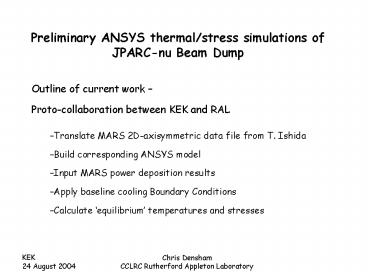KEK PowerPoint PPT Presentation
1 / 14
Title: KEK
1
Preliminary ANSYS thermal/stress simulations of
JPARC-nu Beam Dump
- Outline of current work
- Proto-collaboration between KEK and RAL
- Translate MARS 2D-axisymmetric data file from T.
Ishida - Build corresponding ANSYS model
- Input MARS power deposition results
- Apply baseline cooling Boundary Conditions
- Calculate equilibrium temperatures and stresses
2
Preliminary ANSYS thermal/stress simulations of
JPARC-nu Beam Dump
- Purpose of current work
- Benchmark previous simulation
- Make increasingly realistic simulations e.g.
- Thermal gaps/joints between material blocks
- Temperature dependent and orthotropic material
(graphite) properties - Highlight problem areas (high temperatures/stresse
s) - Propose and investigate potential solutions e.g.
- Change material/distribution new MARS simulation
- Change cooling path
- Sub-divide/shape material
3
Heat Load (Normal Operation, 4MW)
Max. Heat Load 14.0 J/cm3 4.1?/spill
Fe 0.15J/cm3
Total Heat Load 1.1MW sr 15cm
4
Concrete
Cu
Fe
Water cooling path between Cu and Fe h 600
W/m2K (water at 30C)
Free convection around Mupit surface h 6.1
W/m2K (30C) (air at 30C)
5
(No Transcript)
6
Static thermal stresses in unconstrained copper
block only. Von Mises equivalent stress 316 MPa
at 4MW (gt2 x Ultimate Tensile Strength!) NB Beam
pulse thermal shock is additional to this
7
Temperatures in Aluminium Copper Hybrid Beam
Dump Max. temp of Al 628C (cf MP 660C!)
8
Graphite Cu Hybrid design Anisotropic PSG-332
graphite
Copper
Separated but convection linked graphite and
copper surfaces qhfA(T1-T2), Value used hf5
W/m2K
Graphite
Health Warning Thermal conductivity drop for
graphite probably pessimistic Convection link
value pessimistic measured value (Tada) is much
more effective
Temperature
9
Graphite Cu Hybrid design Anisotropic PSG-332
graphite, sub-divided
Separated but convection linked graphite and
copper surfaces qhfA(T1-T2), Value used hf5
W/m2K
Health Warning Thermal conductivity drop for
graphite probably pessimistic Convection link
value pessimistic measured value (Tada) is much
more effective
Temperature
10
Graphite Cu Hybrid design Sub-divided
anisotropic PSG-332 graphite Sub-divided copper
Copper
Graphite
Health Warning Thermal conductivity drop for
graphite probably pessimistic Convection link too
poor measured value (Tada) is much more
effective
Temperature
11
Summary of results so far
12
Preliminary conclusions
- Can successfully translate MARS simulation data
file into ANSYS model. - Success with modeling air/He gaps by convection
links between different modules and material
blocks. - Introducing low z material before copper reduces
peak power density in Cu and consequently reduces
thermal stress. - Current design still limited by maximum thermal
stress in Cu - May be necessary to reduce cooling radius from
1.5 m water activation issues
13
Next steps
- Use better material (graphite) data
- Use measured (M.Tada) convective heat link data
between separate material blocks much higher
value than used in simulations so far - Further sub-divide graphite and copper blocks
- Optimise cooling radius
- Calculate thermal shock (LS Dyna code)
- Perform full 3-D analysis
- Generate conceptual engineering designs get
more people involved at RAL
14
(No Transcript)

